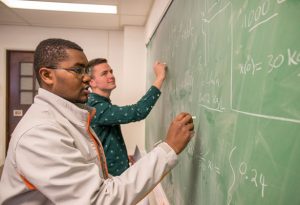Applications in introductory college mathematics
 Students often perceive gateway mathematics courses as lacking relevance to their own interests and goals. In response, they do not appreciate the broader skills that they can acquire by studying mathematics. Due to a need to cover a broad range of topics, the techniques in College Algebra are rarely taught in the context of real world situations. The new math pathways reforms underway in Oklahoma place students in credit-bearing math courses specifically designed to be relevant to their career interests. Course designers and instructors thus now have increased opportunity to incorporate relevant applications into these courses. Productive engagement in modeling real-world problems with mathematical tools can provide students with greater opportunities to understand course content and its relevance.
Students often perceive gateway mathematics courses as lacking relevance to their own interests and goals. In response, they do not appreciate the broader skills that they can acquire by studying mathematics. Due to a need to cover a broad range of topics, the techniques in College Algebra are rarely taught in the context of real world situations. The new math pathways reforms underway in Oklahoma place students in credit-bearing math courses specifically designed to be relevant to their career interests. Course designers and instructors thus now have increased opportunity to incorporate relevant applications into these courses. Productive engagement in modeling real-world problems with mathematical tools can provide students with greater opportunities to understand course content and its relevance.
The MIP leverages educational theory and research results that offer insight into how the need for relevant applications can effectively support active learning. One of the most immediate features of our modeling approach is that mathematical representations refer to real-world objects and quantities that can be described and imagined to aid in reasoning. Contexts stimulate students’ intuitive reasoning, which is often not elicited when students only encounter abstract representations. This concrete reasoning enables students to engage in mental constructions that can subsequently be represented abstractly by variables, expressions, diagrams, and graphs. Furthermore, the equations and models derived from an applied task describe meaningful relationships that can be explored, justified, and questioned, supporting higher-order reasoning skills.
Individuals, however, often fail to notice helpful similarities in structure that would allow them to apply content learned in other contexts. The infamous difficulty of such knowledge transfer raises the need for generalization and diverse application of concepts learned either contextually or abstractly. Initially, concepts can be developed and explored in contexts with familiar quantities and relationships, allowing students’ intuitions and experience to drive decision-making. Such reasoning, however, is typically bound to that initial context. The MIP thus promotes the design of subsequent tasks that engage students in exploring the same mathematical structure 1) in new, perhaps less-familiar contexts or 2) applying the concepts developed in initial tasks as tools for making sense of new situations. In the first case, attention to similarities and differences across the contexts can be used to support students in expressing and applying these structures in more general, mathematical terms. In the second case, the tools can be abstracted from their original contexts, assume a mathematical reality of their own, and serve as a foundation for further exploration. The MIP definition of meaningful incorporation of applications is that
Applications are meaningfully incorporated in a mathematics class to the extent that they support students in identifying mathematical relationships, making and justifying claims, and generalizing across contexts to extract common mathematical structure.
Like fostering a learning environment in which students are active, setting mathematics instruction in context alone does not necessarily improve learning. Students often learn to ignore meaningful interpretation about the context and instead draw from simple linguistic cues of standard problem statements to write an equation, perhaps followed by tacking on a unit to the number found through a mathematical procedure. Further challenges to incorporating applications in mathematics instruction include the additional cognitive load presented by working with both a context and a mathematical concept or lack of sufficient familiarity with the context to even understand the problem or potential solutions. The MIP promotes the design criteria that students’ activity in applications of mathematics be scaffold with initial discussions and assistance making sense of the situation, quantities involved, and basic relationships among them. Students’ experiences exploring a context, collecting data, observing patterns, etc. can both support this initial sense-making and provide a foundation for further mathematization. As students become more familiar with a context and effectively mathematize its elements and logic, these supports may be removed and the context and its models may support further mathematical inquiry. Ultimately, for applications to be used effectively, they must foster students’ engagement in the mental activity on which they will later reflect to construct targeted understandings of particular mathematical concepts.
